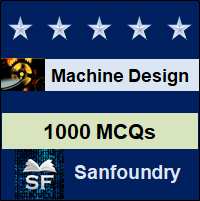This set of Machine Design Multiple Choice Questions & Answers (MCQs) focuses on “Cast Steel & Aluminium Alloys”.
1. Cast steel components do not exhibit the effect of directionality on mechanical properties.
a) True
b) False
View Answer
Explanation: In casting process, there is no control over the fibre structure, thus non directional characteristics for cast steel components.
2. During solidification, cast steel shrinks to quite a great extent
a) True
b) False
View Answer
Explanation: Excessive contractions observed in cast steel.
3. Relative density of aluminium is roughly _______ of steel
a) one-third
b) one-fifth
c) one-tenth
d) equal
View Answer
Explanation: Aluminium alloy=2.7 Steel=7.9.
4. Which of the following statement is true
a) Cast aluminium alloys are specified by a four digit system while wrought alloys by a five digit system
b) Cast aluminium alloys are specified by a five digit system while wrought alloys by a four digit system
c) Cast aluminium alloys are specified by a six digit system while wrought alloys by a five digit system
d) Cast aluminium alloys are specified by a five digit system while wrought alloys by a six digit system
View Answer
Explanation: Standard set for nomenclature.
5. Which of the following are true for aluminium
a) Low specific gravity
b) Corrosion resistance
c) High thermal conductivity
d) All of the mentioned
View Answer
Explanation: All are properties of aluminium.
6. Is it possible to completely relieve the residual stresses in a cast steel product?
a) True
b) False
View Answer
Explanation: Solidification results in great amount of residual stresses.
7. Poor fluidity and contraction are compulsory to be taken into consideration while designing a cast steel product.
a) True
b) False
View Answer
Explanation: Contraction affects to quite a extent in cast steel.
8. In alloy 4450, 2nd digit represents?
a) average percentage of major alloying elements, halved and rounded off
b) average percentage of major alloying elements
c) average percentage of minor alloying elements, halved and doubled
d) average percentage of minor alloying elements
View Answer
Explanation: Second digit is used to represent major alloying element.
9. In alloy 4450, 4 represents?
a) Silicon
b) Aluminium
c) Manganese
d) Zinc
View Answer
Explanation: In alloy nomenclature,1=Al;2=Cu;3=Mn;4=Si;5=Mg.
10. An aluminium alloy casting with 9.8% Cu, 1.0% Fe and 0.25% Mg
a) Alloy 2585
b) Alloy 3586
c) Alloy 2686
d) Alloy 3584
View Answer
Explanation: 1st digit=2(Copper) ; 2nd digit=9.8/2=5 ;3rd digit=8(Iron); 4th digit=5(Magnesium).
Sanfoundry Global Education & Learning Series – Machine Design.
To practice all areas of Machine Design, here is complete set of 1000+ Multiple Choice Questions and Answers.
If you find a mistake in question / option / answer, kindly take a screenshot and email to [email protected]
- Apply for Metallurgical Engineering Internship
- Practice Metallurgical Engineering MCQs
- Check Metallurgical Engineering Books
- Check Machine Design Books
- Practice Mechanical Engineering MCQs

